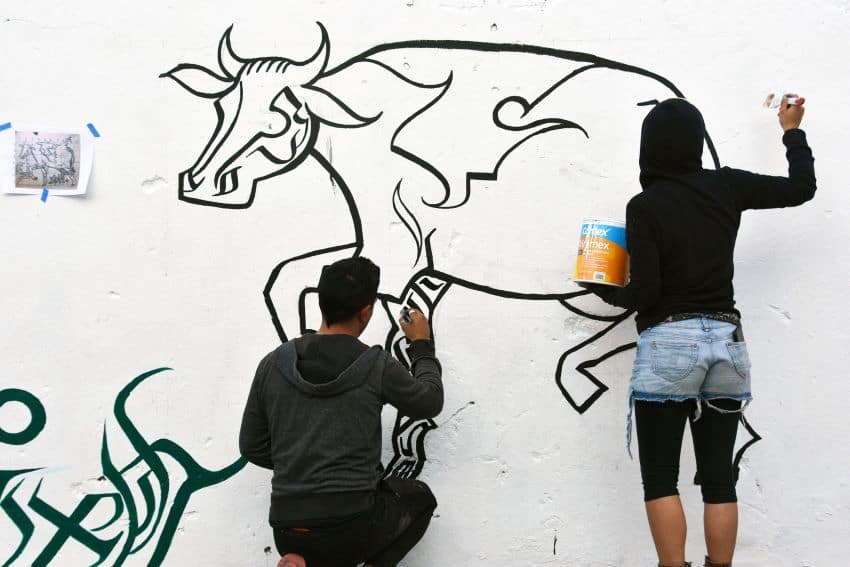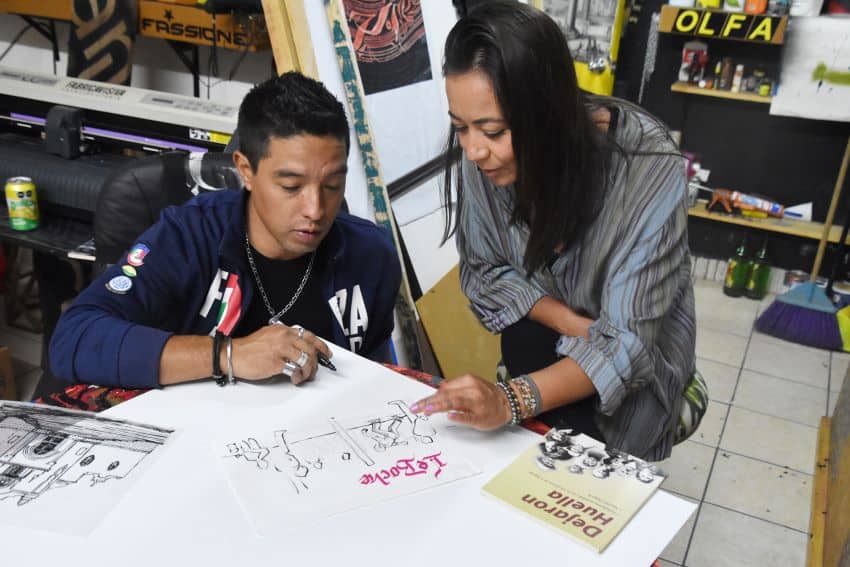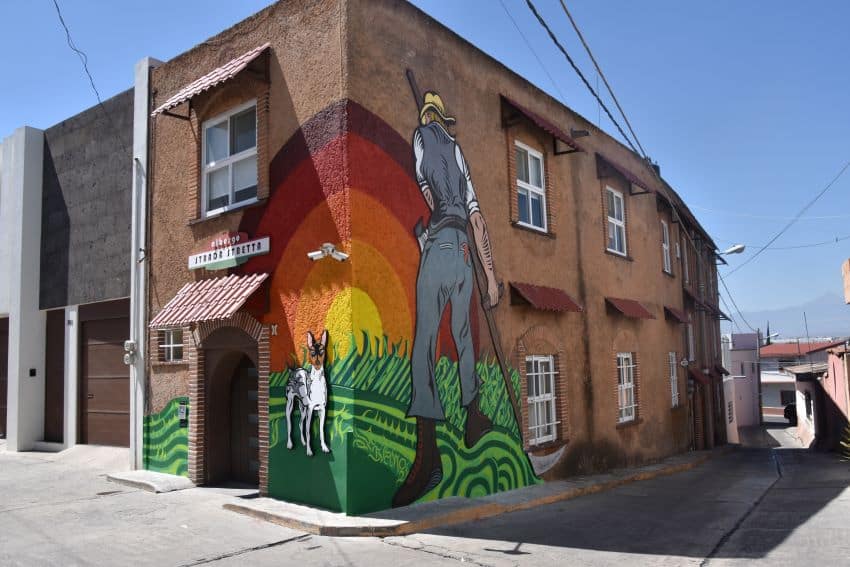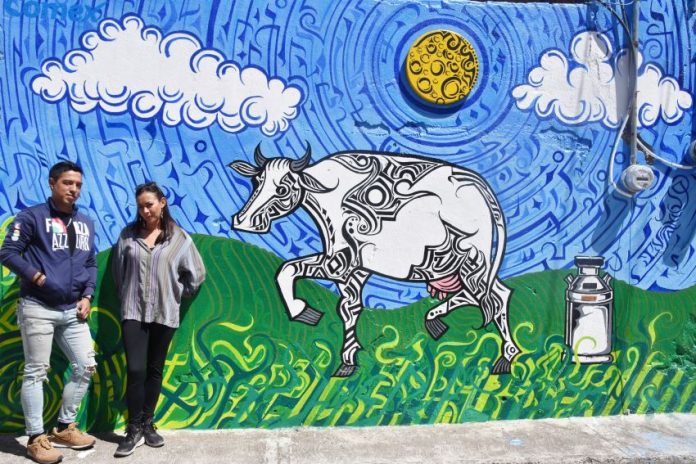Chipilo, a small pueblo south of Puebla, has a lot going for it. Settled in October 1882 by Italians from Veneto, Italy, chipileños (as they’re known) have retained their language, customs and food for generations.
But Zuri Merlo, the director of Chipilo Nostro, the fiesta celebrating the pueblo’s founding, thought there was something missing. “I felt that Chipilo lacked color,” she said.
And so she and chipileño artist Iván Galeazzi Cahuantzi have undertaken an ambitious project to paint 15 colorful murals throughout the pueblo. “I talked with Iván about murals that would show the history of Chipilo,” Merlo said.
Galeazzi liked the idea, in part, because his art would be accessible to more people. “When I make something for a client, it is shown in a private space, but a mural,” he said, “a mural is for everyone.”
Although Merlo and Galeazzi have been friends since they were children, this is the first time they’ve worked on a project together. Merlo takes care of a lot of the nuts-and-bolts aspects needed to keep moving the project forward.

“I get the permits from the municipio [municipality] when we want to paint a mural in a public space,” Merlo said. “For those in private places, we do not need permits; we just need to talk to the owners. People may say, ‘I have this wall, and I would like a mural there.’ We go and look at it. Iván decides what to paint there.”
She has also solicited supplies from the Comex paint store in Chipilo.
Getting to the finished mural is a team effort. “I read about the history of Chipilo, the history of Veneto. I study old photos and paintings. I start with a sketch. Zuri may make suggestions, may suggest colors.” She also helps to paint the murals. “One of the most important aspects,” he continued, “is to show the chipileño identity. We are a small pueblo that has a lot of stories to tell.”
The first mural, on 3a nte. colonia Centro, a small side street just a short distance away from a church, is a painting of a cow. “Cows are very much a part of Chipilo,” Galeazzi said.
He’s greatly influenced by master painters, and his cow is based on one painted by Dutch Renaissance artist Pieter Brugel. It took Galeazzi and Merlo five days to complete the mural, working five to six hours a day.
The second mural, a much larger one, is located on the side of the Hotel Albergo Strada Stretta and depicts a campesino (farmer) cutting plants with a scythe. “The idea for that mural was to show when Chipilo was more rural,” Galeazzi said. “It was to have a campesino working.”

The farmer is two stories tall. Like the painting of the cow, Galeazzi based him on a figure by another master painter, this time Vincent van Gogh. He’s accompanied by his dog, a ratonero (rat terrier), which is by far the most popular dog in Chipilo. Galeazzi and Merlo worked for a month on that mural, putting in about 60 hours.
The two hope to complete 13 of the 15 murals this year, covering a variety of aspects of daily life in Chipilo as well as the pueblo’s history. They’ll paint one about the men who gather to play bocce on Sundays, another about La Befana, a ceremony brought over from Italy where a figure of a witch is burned on the evening of January 5 and one about El Fontanón, an old site where people used to swim and wash clothes. There will also be one that depicts how Chipilo’s economy has changed over the years.
The majority of chipileños used to have dairy farms, and Chipilo was mainly famous for its cheeses and other dairy products. Now the pueblo is also known for its furniture, and there are more carpinterías (carpentry shops) and furniture factories than there are dairy farms.
“There will be a mural about the carpenterías,” said Galeazzi. “That mural will go on the building that housed Seguisimo, the first furniture factory in Chipilo.”
The last two murals, which won’t be completed until next year, may be the most impressive; they’ll certainly be the most extensive. One will be painted on two sides of the building that houses the presidencia, a municipal building. “That mural will depict the history of Chipilo,” said Merlo, “from its beginning to the present.”
The other will be a series of murals on a small hill called Monte Grappa. The hill in Chipilo is named for the mountain in Italy where a battle was fought between the Italian and Austro-Hungarian armies during World War I. On top of that Italian mountain is a cemetery containing the bodies of almost 23,000 soldiers who died in the war.

“When I went to Italy, I had no idea about what happened there, nothing about Monte Grappa,” Galeazzi said.
He decided to show that history to Chipilo, where there’s a memorial at the top of the hill dedicated to chipileños who died in World War I. A plaque to their memory sits beneath a stone brought from the Italian mountain in 1924. Nearby is a large statue of Christ, and below it, Galeazzi plans a painting of Veneto’s Monte Grappa.
He has other ideas for the low walls along the periphery, where there are benches. “There will be four murals depicting the first world war, which in Italy is called ‘The Great War,’” he said. “The murals there will show the battles [and] the graves.”
When they’re not working on murals, the two are occupied with their individual work: in addition to organizing Chipilo Nostro, Merlo has a business promoting and selling artisanal foods made in the pueblo. Galeazzi has a busy art and design studio.
Although the mural project will take up much of their time over the next year or so, they’re committed to completing it. “It is a labor of love,” said Merlo. “Love of art, love of Chipilo.”
Merlo and Galeazzi are looking for funding to help complete the project. Anyone interested in donating may contact them via [email protected].
Joseph Sorrentino, a writer, photographer and author of the book San Gregorio Atlapulco: Cosmvisiones, is a regular contributor to Mexico News Daily. More examples of his photographs and links to other articles may be found at www.sorrentinophotography.com He currently lives in Chipilo, Puebla.
